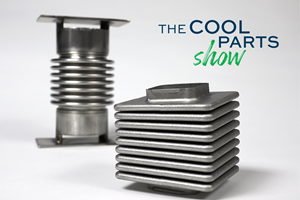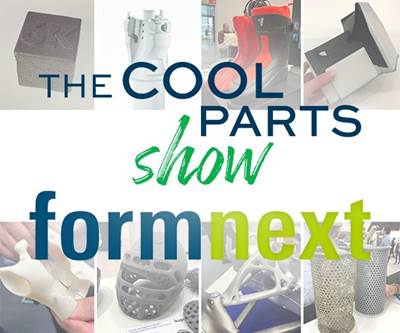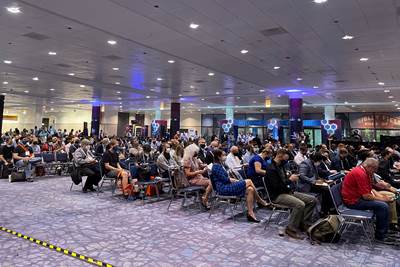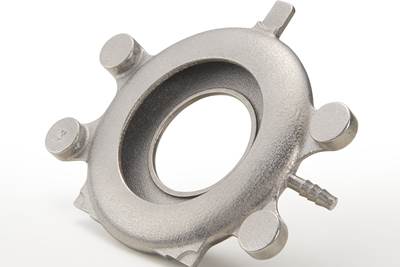8 Cool Parts From RAPID+TCT 2021: The Cool Parts Show #32
North America’s largest AM trade show resumed! Here are some of the coolest cool parts we found.
Share
The largest annual trade show in North America devoted to additive manufacturing (AM) went longer than two years without being held because of the pandemic. Now, RAPID + TCT has resumed; the show was held this past week in Chicago’s McCormick Place. The pandemic still made its presence felt — attendees were masked and attendance was understandably down — but the show was a resounding success for the extent to which is showcased the continuing advance of AM technology and application. Cohost Stephanie Hendrixson and I were there, and plenty of intriguing 3D printed parts caught our attention and imagination. In fact, we discovered too many cool parts to mention in one brief episode of the show, so here are our selections: eight cool parts we found at RAPID + TCT 2021. | This episode of The Cool Parts Show brought to you by Carpenter Additive
The Cool Parts Show is a video series from Additive Manufacturing Media that explores the what, how and why of unusual 3D printed parts. Watch more here.
Have a cool part to share? Email us.
Related Resources
- Rapid + TCT
- Velo3D and metal 3D printing without support structures
- Paramatters and generative design
- Anisotropic optimization software developed with Covestro
- Desktop Metal’s Shop system for binder jet metal AM
- Azul 3D, developers of the high-speed Lake 3D printer
- Origin and digital light processing for polymer AM
- Helicopter oil collector redesign
- Nexa3D and production-speed polymer 3D printing
- Fortify and 3D printing with magnetic alignment
- The AM Radio podcast and more of our observations and commentary on RAPID + TCT 2021
Transcript
Peter Zelinski
Hey, I'm Pete Zelinski.
Stephanie Hendrixson
I'm Stephanie Hendrixson.
Peter Zelinski
This is The Cool Parts Show if you're new to the show, this is our show about 3D printing for end use parts and this is a special episode.
That's right. We just got back from Rapid + TCT. Usually North America's largest 3D printing tradeshow. This particular instance in 2021 was maybe the first major 3D printing tradeshow since 2019. So it was a really big deal.
Peter Zelinski
So Rapid + TCT. This year, it was in Chicago at McCormick Place. It found some space in McCormick after the show was postponed from the spring into the fall. Attendance was down understandably, because of the pandemic. We were all wearing masks but additive manufacturing technology is advancing. We saw the advances. There were plenty of people there talking about it excited about it. And we found all kinds of cool 3D printed parts actually too many to talk about them all.
Stephanie Hendrixson
That's right and regular viewers of the show will know that each episode we usually just focus on one 3D printed part. This is a special episode so we are going to take you through eight of the coolest parts that we saw at the show. In no particular order. These are just like the coolest 3D printed things that stood out to us.
Peter Zelinski
Here they come right after this.
Stephanie Hendrixson
This episode of The Cool Parts Show is brought to you by Carpenter Additive. The company's PowderLife solution is a combination of hardware and software technologies designed to help AM users manage their metal powders. Stay tuned after the episode for more on how the system works.
Peter Zelinski
All right, no particular order, not a countdown. They're all cool, but let's start here. Okay, so this part exemplifies this theme I kept finding at Rapid this year, which is parts succeeding in additive without any particular redesign needed. This is a static mixer cutaway view. Two fluids get mixed together because of all those little barriers on the inside. Typically, this is an assembly welded in, the welding is difficult time consuming. You also have to think about the weld materials interaction with the fluids you're trying to mix. Alternately, this was 3D printed in one piece, eliminating all that assembly. Velo3D made it material is Hastelloy, and notably this, this relies on Velo3D’s signature capability to print overhangs in metal with little or no supports. printing this width supports would be problematic. Getting those supports out of this enclosed volume would be impractical, impossible. Talk to CEO Benny Buller at the show the founder of Velo3D and he talked about how there are all these parts that somehow deal with fluid internally fluid flow applying energy to fluid, you find him in fuel systems processing facilities, and all those components are wide open application opportunities for additive manufacturing.
Stephanie Hendrixson
This next part is a bracket for Airbus or more accurately, the part that I saw at the show was an interrupted print of this bracket, and they stopped the print on purpose to be able to show the path of the filament through the part. So what this part is demonstrating is an issue that I wasn't really aware of until the show but the fact that when you are using a carbon fiber reinforced filament, the way that you lay the filament matters, even though the carbon fiber is chopped up inside of the material, the fibers tend to align in the path of the filament and so the orientation that you printed helps dictate the the final strength of the part. So this is an example from a collaboration between software company Paramatters and materials company Covestro aimed at trying to solve this problem. The bracket is printed from Novamid CF which is one of Covestro's, carbon fiber reinforced filaments. So what these two collaborators have done is created a software solution they're calling an isotropic generative design. So use computer simulation and the loads you expect to see on the part to generatively design the outer form of the piece, but then also simulate the way that the fibers should be oriented inside the part and use that to determine the G code of the printer. Airbus has been testing the software at its composite technology center and this bracket is an early success that they're seeing. As a result the partnership is also finding interest from other aerospace OEMs and additional companies as well.
Peter Zelinski
Okay, so here's a hardware component for downhole tool in the oil and gas industry lots of names for this part. Tool slip is one, it kind of helps hold the tool together and also guide the tool into the hole. The little divots you see in the in the part carbide buttons go in there to help with with guiding the tool. And here is another case of a part that made the transition from conventional manufacturing to additive manufacturing without any geometric redesign. Traditionally, this is machined PGV Industries seize opportunity to make this piece of hardware but actually there's many sides shapes varieties of the tool slip, but to make hardware components like this through 3D printing through binder jet, so the company made this part on desktop metals, shop binder jet system, and no geometric redesigned, but there was one important change. When this is machined to save cost to simplify machining, it's made out of 4140 steel tool steel. But corrosion is a problem. Switch to 3D printing and 3D printing with stainless steel is very easy, very doable, so that material is used instead, apart that is unchanged except the material change makes it better performing.
Stephanie Hendrixson
Now to the world of sports. Our next cool parts are paddles made for pickleball. The fastest growing sport in America, I learned. Conventionally these paddles are made from multiple different materials, they're assembled together. And they also have one big problem. They are loud. So these paddles that I saw at the show were 3D printed by Azul 3D using their Lake 3D printer. It's a DLP system, and it's very fast, they say that they can deposit up to six inches of material per hour, and it takes about seven hours to fill the entire bill volume of the printer. So DLP is a process that relies on curing the material, there's not heat used for melting. But when you're going that fast, actually heat does become an issue. So this printer has an oil barrier in between the optics and the resin that does a couple of things, but one of which is to help control and regulate the temperature. So Azul 3D experimented with 3D printing the entire paddle as well as just the inner core, they came up with this three dimensional honeycomb structure that helps give better feedback to the player. It could also be customized to particular players and their and their style and it also makes these paddles much quieter.
Peter Zelinski
Alright, more DLP, digital light processing. So Stephanie, in the category of San Francisco based DLP 3D printer makers recently acquired by Stratasys. What do you got?
Stephanie Hendrixson
It can only be Origin.
Peter Zelinski
Alright, Rapid was the first show for Stratasys debuting Origin as part of its offerings, and introduced new materials for that platform too. So this scooter is made from Dura 56 photopolymer from Loctite, hard resilient material, the scooter kind of shows what's possible proof of concept here. Stephanie, you've seen these Origin machines. And what you might be thinking right now is you can't fit a scooter in there. So it was made in pieces, two pieces for the handle four wheels. And then that main part that you stand on was 3D printed in three different pieces. Another case, no redesign needed. The parts were not hollowed out the way you often do with 3D printed structural forums, no lattices that is a design freedom of additive but not used here. These parts are basically solid polymer bricks. And what that shows is, the process control is sufficient that you can print dense parts without distortion. These parts were accurate enough, they were seamlessly assembled together, the scooter works.
Stephanie Hendrixson
Alright, so let's get back to metals for a second here. My next part is an oil collector for a fleet of helicopters. We talk sometimes about 3D printing as a solution for making legacy parts or for optimizing new systems that are coming out. This is sort of an interesting case because this is a part that did not exist on the original helicopter. But there was a problem with oil leakage. And so this part was designed and made to help mitigate that issue to help optimize the operation of a system that was already in place. This part was 3D printed by Allegheny Technologies Inc, or ATI a company that produces metals. They specialize in mostly aerospace grade metals. They also provide 3D printing services as well. This oil collector was 3D printed using electron beam melting or EBM. You can see there's a pretty significant overhang on the inside and so they chose EBM to avoid the need for support structures and the difficulty that would be involved in removing those support structures. They did add a couple of features though to help make the finished machining a little bit easier. This part is made from Tie 64. So I knew a little bit about this part going into the show because I've actually written about it already. But this is my first time seeing it in person. I knew it was lightweight, but I was really surprised by just how lightweight it was when I actually got to to pick it up. So you can learn lots more about this and how it was developed and printed in just four months through the story at our website additive manufacturing dot media and we'll also put a link in the show description.
Peter Zelinski
Next up: telemedicine. We've all been working remotely. Doctors have been working remotely but a challenge of telemedicine is the stereotypical doctor accessory. The stethoscope. How do you do a stethoscope virtually? So here's how this product is a remote stethoscope, you send it to the patient, and the physician can listen digitally through an app. So this product is from WeMed. It is a French startup launched to to deal with the technology challenges of telemedicine made through 3D printing, there's a couple things going on here. One is biomimicry, the inner form shaped much like a human inner ear to help with gathering in sound. The result is a form you'd be challenged to make any other way except through 3D printing. Also precision, these parts are made precisely enough that the product snaps together assembly is that simple. The material is from Loctite. This is made through DLP on a platform from Nexa 3D contract manufacturer called Third has Nexa's printers wash station curing station, the print time is fast enough that additive manufacturing is a solution for full scale production. WeMed intends to produce this at a volume of 100,000 units per year relying on 3D printing.
Stephanie Hendrixson
So again, we saw way more cool things that we could include here. But our last cool part for this video is actually a collection of similar cool parts. These are radio frequency lenses or RF lenses used to guide direct focus radio waves. These were 3D printed by fortify using their flux 3D printer. It's a DLP platform that has been optimized to print highly viscous and highly filled materials. The material used here is a dielectric composite developed with Rogers Corporation for high frequency communication systems. Typically, lenses like this would be assembled from lots of different cast and molded materials, which is a process that takes time it's difficult, it can be costly. 3D printing delivers the geometric complexity to allow you to print something like this in just one piece. And more than that to to vary the lattice structure to vary the amount of material used throughout the lens to to help focus and shape those radio waves. So simplifying production, but also improving performance, which means you can use less energy and you need fewer of these devices. Overall, lenses like this are going to become increasingly important with the continued rollout of 5g and high throughput satellite systems.
Peter Zelinski
Okay, so that's our quick sample of cool parts at Rapid + TCT. For more of our observations of the show, actually a lot more, we've got a place for you to go.
Stephanie Hendrixson
That's right. If you're interested in the trends, the technologies, our impressions of the event, check out our new podcast AM Radio; we have an episode where we get into all of that, as well as a slideshow with other cool and interesting things that we saw in Chicago. We'll put links to all that in the description below.
Peter Zelinski
If you're seeing The Cool Parts Show for the first time, we're glad you're here. Check out all our earlier episodes, thecoolpartsshow.com.
Stephanie Hendrixson
If you liked the show, we hope you'll subscribe leave us a like leave us a comment. And as always, thank you for watching.
Stephanie Hendrixson
Thanks again to our sponsor, Carpenter Additive. In addition to supplying metal powders, the company also offers services, software and hardware to help AM users manage their powder. One example is the PowderLife system, a combination of cloud-based tracking software with hardware designed to make powder handling easier. Two key components are the powder life hopper and the automated docking stations. Luke Boyer, manager of powder life applications, and Andrew Holliday, applications enginee,r explained how the system works.
Luke Boyer
So, today when a user of additive manufacturing is receiving powder, they oftentimes receive it in either 5, 10, 15 maybe a 20 kilo bottle, but they're receiving pallets of them and you're receiving 10, 20, 50, hundreds of these bottles. The user has to look in and segregate and store them appropriately so the bottles don't get mixed up, and it requires a lot of lifting and moving and labor.
Andrew Holliday
The components of PowderLife are all based around making the powder management systems, the additive manufacturing shop floor, easier to use for the operator, and cleaner, as well as more traceable. Three of those basic parts of PowderLife are our PowderLife hoppers or our storage containers for powder. The second would be automated docking systems that allow material to be pushed in and out of machines with no human contact. The third would be our PowderLife online software system that allows you to trace this powder as it goes through your shop floor.
Luke Boyer
The hardware and software together just help really streamline that and improve the final user’s experience and let them concentrate on going from design to the part itself. It takes the headache of powder management out of the equation.
Related Content
Understanding PEKK and PEEK for 3D Printing: The Cool Parts Show Bonus
Both materials offer properties desirable for medical implants, among other applications. In this bonus episode, hear more from Oxford Performance Materials and Curiteva about how these companies are applying PEKK and PEEK, respectively.
Read More3D Printed Spacer Grids for Nuclear Power: The Cool Parts Show #79
Westinghouse Electric Company is exploring laser powder bed fusion as a means of manufacturing spacer grids, critical parts of the fuel rod assemblies used in pressurized water reactors.
Read MoreThis Drone Bird with 3D Printed Parts Mimics a Peregrine Falcon: The Cool Parts Show #66
The Drone Bird Company has developed aircraft that mimic birds of prey to scare off problem birds. The drones feature 3D printed fuselages made by Parts on Demand from ALM materials.
Read MoreFlexible Bellows Made Through Metal 3D Printing: The Cool Parts Show #64
Can laser powder bed fusion create metal parts with controlled flexibility? We explore an example in this episode of The Cool Parts Show.
Read MoreRead Next
8 Cool Parts from Formnext 2019: The Cool Parts Show #6
Editors Peter Zelinski and Stephanie Hendrixson attended Formnext 2019 in Frankfurt, Germany. Here are 8 cool 3D printed parts spotted on the show floor.
Read MoreImpressions and Trends from RAPID + TCT 2021: AM Radio Bonus
Peter Zelinski, Stephanie Hendrixson and Julia Hider discuss what they saw, heard and learned at RAPID + TCT 2021 in a special episode of the AM Radio podcast plus slideshow.
Read MoreOil Collector Upgrade for Legacy Helicopters Is a 3D Printed Pathfinder Part
The lightweight part was delivered faster and made more easily via electron beam melting (EBM) than a conventionally manufactured alternative could be produced, while also illuminating a way forward for upgrading other existing systems.
Read More















